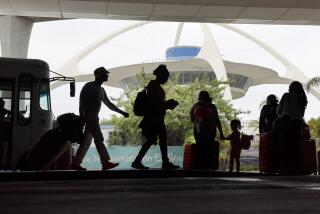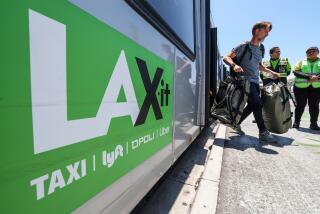LAX ‘VIP Lines’ May Be Axed
For harried business travelers, navigating the nation’s airports post-9/11 has meant long lines, uncertain departure times and hours of waiting. But the airlines created at least one perk to pacify their best customers: special “VIP lines” at crowded security checkpoints.
So it was with confusion, anger and occasionally resignation that frequent fliers greeted the news this week that transportation bureaucrats were trying to take away the shorter, faster lines.
The fledgling Transportation Security Administration ordered the airlines to eliminate the popular VIP lines Sunday. That’s when the agency officially assumed responsibility for screening checkpoints at the nation’s 429 commercial airports. The 3-month-old TSA said the move was necessary to make screening more consistent and efficient from airport to airport and passenger to passenger.
Airlines interpreted the order in myriad ways. At Los Angeles International Airport, some carriers ignored the request. At other locales, airlines put signs for priority lines back in place when their competitors failed to comply. Airlines complained that federal security employees were enforcing the plan inconsistently. And the confusion prompted the security bureaucrats to clarify their instructions.
The imbroglio illustrates the enormous challenges facing the TSA, which was created last year by Congress to revamp security at the nation’s airports. As in the case of VIP lines, the agency and its security imperative are expected to repeatedly collide with the airlines’ insistence on easing the way for their customers.
“There will be conflicts every step of the way,” predicted Billie H. Vincent, a former Federal Aviation Administration security chief. “Knowing the nature of the industry, the airlines and the airports both will resist doing things.”
TSA officials urged patience as bureaucrats work to build the organization while scurrying to comply with stringent deadlines in the new aviation security bill.
“This is a big system starting up quickly,” said Jim Mitchell, a TSA spokesman. “We have a lot of new people in airports representing us, and there are a few situations where things are not the way we want it to be.”
The biggest carriers, including United, American, Northwest, Delta and Continental, created the VIP lines after the terrorist attacks to lure lucrative business travelers back to the skies.
Those coveted fliers produce the bulk of airlines revenues.
It was perhaps no surprise, then, that the carriers responded to Sunday’s “no-VIP line” rule by trying to preserve as much privilege for frequent fliers as they could.
Northwest Airlines insisted that its 2-month-old “exclusive security lanes” in cities including Detroit, Seattle, Chicago and Los Angeles remain legitimate because the separate lines end before they reach security checkpoints. The lines feed into a single set of baggage X-ray machines and metal detectors used by all customers.
Other airlines quickly adopted this argument.
After initially expressing doubts about the continue use of elite lines, the federal agency later said the lines would be allowed--as long as all passengers had equal access to security equipment.
Though the airlines insisted that they are complying with the federal directive, the reality at LAX this week showed something different.
On Thursday morning, a United employee guided frequent fliers through a designated first class line that fed into two X-ray machines and metal detectors. Other passengers were routed around these machines to another, longer line.
At American Airlines’ Terminal 4, first and business class passengers also were directed to a separate line. Although there was no VIP sign, an airline employee waved them toward that line, where only a handful of people waited.
Most coach class passengers followed the natural flow of traffic to a much longer general security line, where they had to wait with dozens of others to be scanned.
As in the United terminal, the queue where first and business class passengers were directed by American employees had its own X-ray machine and metal detector.
Federal security officials said they knew some airlines were violating the directive by directing frequent fliers to special checkpoints. But officials at the TSA said they have authority over the screening areas, and will eventually ensure that the airlines comply.
The new equilibrium at the terminals was only beginning to dawn on travelers. And many business fliers weren’t happy to hear that their special shortcuts might be eliminated.
“Yes, it matters,” snapped Steve Wasserman, 40, an investment banker traveling to New York. Wasserman, who logs 70,000 miles a year in the air, was perspiring as he said he had only a few minutes to reach his flight.
Others agreed.
“It’s a horrible idea,” said Elias AbuShanab, 34, a retail executive with a clothing firm. “Certainly because I travel a lot, and business travelers are how the airlines make their money.”
But several other executives exhibited the spirit of cooperation still evident at many of the nation’s airports since the attacks.
“It used to take me 15 minutes to get on an airplane,” said Andy Espinosa, 60, a salesman who travels twice a month. “These lines are good for us. On the other hand, I can see why others would be frustrated by it. We need to combine solidarity and privileges.”
The pressure from businesspeople and airlines for greater speed promises to color the security discussions for years to come.
Marianne McInerney, executive director of the National Business Travel Assn., said companies suffer billions in lost productivity when employees get stuck in airports.
Those travelers expect “an efficient security process universally across the entire system,” said McInerney, whose organization represents corporate travel departments at companies such as Coca-Cola Co., Johnson & Johnson and Gap Inc.
“Travel is a huge economic driver in our economy,” McInerney said. “So if companies stand to lose $12 billion a year, and the traveler knows it will take two to three hours for the travel experience, is there a better alternative? Yeah. Are they going to stay home? Absolutely.”
Times staff writers Ricardo Alonso-Zaldivar and James F. Peltz contributed to this report.
More to Read
Inside the business of entertainment
The Wide Shot brings you news, analysis and insights on everything from streaming wars to production — and what it all means for the future.
You may occasionally receive promotional content from the Los Angeles Times.










